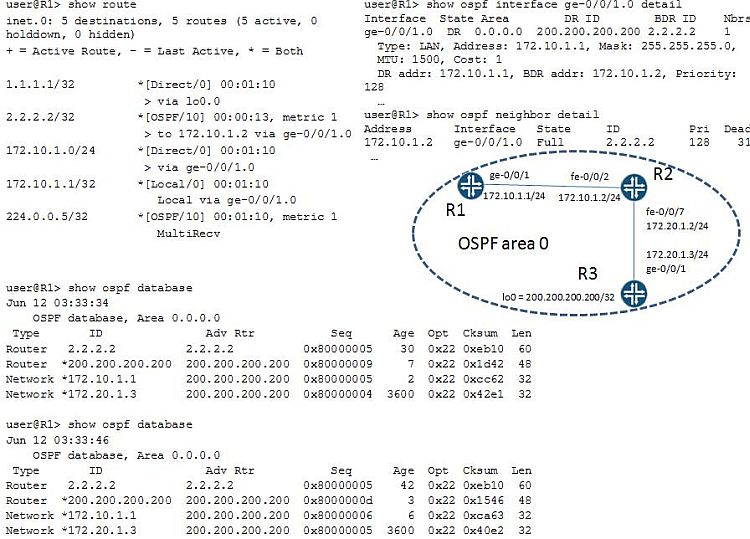-- Exhibit --
user@router> show ospf database
Area 0.0.0.1 -
Type ID Adv Rtr Seq Age Opt Cksum Len
Router 172.24.255.1 172.24.255.1 0x800000d4 182 0x22 0x59f3 36
Router 172.24.255.2 172.24.255.2 0x800000d4 177 0x22 0x57f2 36
Router *172.24.255.4 172.24.255.4 0x800000dc 176 0x22 0x75fa 72
Network 172.24.124.2 172.24.255.2 0x80000007 177 0x22 0x7957 36
Summary 172.24.13.0 172.24.255.1 0x80000004 2370 0x22 0x3f62 28
Summary 172.24.23.0 172.24.255.1 0x80000002 471 0x22 0xdeb9 28
Summary 172.24.255.1 172.24.255.1 0x800000cb 2037 0x22 0x2bbb 28
Summary 172.24.255.2 172.24.255.2 0x800000cc 487 0x22 0x19ca 28
Summary 172.24.255.3 172.24.255.1 0x80000003 140 0x22 0xb2f9 28
OSPF AS SCOPE link state database
Type ID Adv Rtr Seq Age Opt Cksum Len
Extern *1.47.82.0 172.24.255.4 0x80000002 1037 0x22 0x4225 36
Extern *100.0.0.0 172.24.255.4 0x80000001 2643 0x22 0xfc88 36 user@router> show ospf neighbor
Address Interface State ID Pri Dead
172.24.124.2 ge-0/0/1.0 Full 172.24.255.2 128 36
172.24.124.1 ge-0/0/1.0 Full 172.24.255.1 128 30
user@router> show ospf interface ge-0/0/1.0 extensive
Interface State Area DR ID BDR ID Nbrs
ge-0/0/1.0 PtToPt 0.0.0.1 0.0.0.0 0.0.0.0 2
Type: P2MP, Address: 172.24.124.4, Mask: 255.255.255.0, MTU: 1500, Cost: 1
Adj count: 2 -
Hello: 10, DeaD. 40, ReXmit: 5, Not Stub
Auth type: None -
Protection type: None -
Topology default (ID 0) -> Cost: 1
user@router> show route protocol ospf table inet.0
inet.0: 11133 destinations, 11135 routes (11133 active, 0 holddown, 0 hidden)
+ = Active Route, - = Last Active, * = Both
224.0.0.5/32 *[OSPF/10] 1w0d 00:01:14, metric 1
MultiRecv -
-- Exhibit --
Click the Exhibit button.
Referring to the exhibit, why are the OSPF routes missing from the routing table for this router?
- A. mismatching OSPF interface type with the neighbor
- B. MTU mismatch with the neighbor
- C. incorrect IP address configured on the interface
- D. no Type 4 LSAs in the OSPF database
Answer : A
-- Exhibit --
user@router> show route protocol bgp detail
inet.0: 20 destinations, 20 routes (19 active, 0 holddown, 1 hidden)
10.222.1.3/32 (1 entry, 1 announced)
*BGP Preference: 170/-101
Next hop type: Indirect -
Address: 0x15ec944 -
Next-hop reference count: 3 -
Source: 1.1.1.1 -
Next hop type: Router, Next hop index: 536
Next hop: 1.1.1.1 via ge-0/0/1.0, selected
Protocol next hop: 1.1.1.1 -
Indirect next hop: 14081d0 262142
State:
Local AS: 65222 Peer AS: 65221 -
Age: 2:12 MetriC. 1 Metric2: 0 -
Task: BGP_65221.1.1.1.1+56417 -
Announcement bits (2): 0-KRT 4-Resolve tree 1
AS path: 65221 I -
Communities: no-advertise -
Accepted -
Localpref: 100 -
Router ID. 10.222.1.1 -
-- Exhibit --
Click the Exhibit button.
You are troubleshooting a problem where an EBGP route is not being advertised to your local IBGP peers. You have received a 10.222.1.3/32 route from an EBGP peer as shown in the exhibit, but the route is not being advertised.
What is causing the problem?
- A. The route shows as a hidden route and cannot be advertised.
- B. The next hop for the route is indirect and prevents the route from being advertised.
- C. The community prevents the route from being advertised.
- D. The local preference value is too high for the route to be advertised.
Answer : C
-- Exhibit --
protocols {
bgp {
group isps {
type external;
peer-as 13090194;
multipath multiple-as;
neighbor ;
neighbor ;
-- Exhibit --
Click the Exhibit button.
The exhibit shows the complete BGP configuration for a router. The network operator reports that both peering sessions are up, but the router is not conducting per-flow load balancing over the connections to these two peers.
What are two causes for this behavior? (Choose two.)
- A. The forwarding-table export policy is not configured to cause per-flow load balancing.
- B. The multiple-as parameter causes BGP to only choose multiple paths to different ASs, rather than multiple paths to the same AS.
- C. The router has different IGP metrics to these BGP peers.
- D. The BGP peers are not sending identical advertisements over the two sessions.
Answer : A,D
You use static routes for connectivity to the ISP. Your ISP recently switched to using different links for multicast and unicast traffic. Following the change, users in your company were unable to receive multicast traffic through the ISP.
What must you configure on your router to reestablish multicast connectivity to your ISP?
- A. Add a static default route to the ISP in the inet.2 routing table.
- B. Add the default-rpf-interface parameter under the [edit routing-options multicast] hierarchy.
- C. Add the upstream-interface parameter under the [edit protocols pim] hierarchy.
- D. Disable PIM on the interface used for unicast traffic.
Answer : A
-- Exhibit

-- Exhibit --
Click the Exhibit button.
Referring to the exhibit, you are configuring an OSPF network. All OSPF adjacencies come up and stay stable. But neither R1 nor R2 has the prefix 200.200.200.200/32 in its routing table.
What is causing this problem?
- A. R2 does not have the export policy for prefix 200.200.200.200/32.
- B. R1 does not have routes to network 172.10.1.0/24.
- C. R2 is BDR on both network 172.10.1.0/24 and 172.20.1.0/24.
- D. The router ID of R1 is the same as the router ID of R3.
Answer : D

